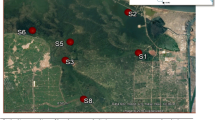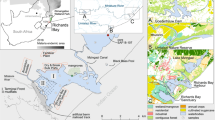Abstract
The California’s San Joaquin River and its tributaries including Orestimba (ORC) and Del Puerto (DPC) Creeks are listed on the 2006 US EPA Clean Water Act §303(d) list for pesticide impairment. From December 2007 through June 2008, water and sediment samples were collected from both creeks in Stanislaus County to determine concentrations of organophosphorus (OP) and pyrethroid insecticides and to identify toxicity to Ceriodaphnia dubia and Hyalella azteca. OPs were detected in almost half (10 of 21) of the water samples, at concentrations from 0.005 to 0.912 μg L − 1. Diazinon was the most frequently detected OP, followed by chlorpyrifos and dimethoate. Two water samples were toxic to C. dubia; based on median lethal concentrations (LC50), chlorpyrifos was likely the cause of this toxicity. Pyrethroids were detected more frequently in sediment samples (18 detections) than in water samples (three detections). Pyrethroid concentrations in water samples ranged from 0.005 to 0.021 μg L − 1. These concentrations were well below reported C. dubia LC50s, and toxicity was not observed in laboratory bioassays. Cyfluthrin, bifenthrin, esfenvalerate, and λ-cyhalothrin were detected in sediment samples at concentrations ranging from 1.0 to 74.4 ng g − 1, dry weight. At DPC, all but one sediment sample caused 100% toxicity to H. azteca. Based on estimated toxicity units (TUs), bifenthrin was likely responsible for this toxicity and λ-cyhalothrin also contributed. At ORC, survival of H. azteca was significantly reduced in four of the 11 sediment samples. However, pyrethroids were detected in only two of these samples. Based on TUs, bifenthrin and λ-cyhalothrin likely contributed to the toxicity.
Similar content being viewed by others
References
Amweg, E. L., Weston, D. P., & Ureda, N. M. (2005). Use and toxicity of pyrethroid pesticides in the Central Valley, California, U.S.A. Environmental Toxicology and Chemistry, 24, 966–972; Erratum 24, 1300–1301.
Amweg, E. L., Weston, D. P., You, J., & Lydy, M. J. (2006). Pyrethroid insecticides and sediment toxicity in urban creeks from California and Tennessee. Environmental Science & Technology, 40, 1700–1706.
Bacey, J., Starner, K., & Spurlock, F. (2004). The occurrence and concentration of esfenvalerate and permethrin in water and sediment in the Sacramento and San Joaquin Watersheds. CDPR Report EH 04–01. http://www.cdpr.ca.gov/docs/emon/surfwtr/swemreps.htm. Accessed 31 July 2008.
CAL/EPA (2009). Central valley regional water quality control board. http://www.swrcb.ca.gov/centralvalley/water_issues/tmdl/impaired_waters_list/index.shtml. Accessed 1 June 2009.
CDPR (2009a). California Department of Pesticide Regulation’s Pesticide Information Portal, Pesticide Use Report (PUR) data. http://www.cdpr.ca.gov/docs/pur/purmain.htm. Accessed 22 Sept 2008.
CDPR (2009b). Insecticide analytical methods. http://www.cdpr.ca.gov/docs/emon/pubs/em_methd_insect.htm. Accessed 17 November 2008.
Gunasekara, A. (2006). California Department of Pesticide Regulation SOP number METH005.00: Instructions for calibration and use of total organic carbon (CD-85A) instrument. http://www.cdpr.ca.gov/docs/empm/pubs/sops/meth005_00.pdf. Accessed 31 Oct 2007.
Haver, D. L., Oki, L., Bondarenko, S., Holmes, R., Mazalewski, R., Majcherek, T., et al. (2008). Detection of pesticides in residential runoff, (p. 41). Abstracts, 5th Biennial CALFED Science Conference, Sacramento, CA.
Holmes, R. W., Anderson, B. S., Phillips, B. M., Hunt, J. W., Crane, D. B., Mekebri, A., et al. (2008). Statewide investigation of the role of pyrethroid pesticides in sediment toxicity in California’s urban waterways. Environmental Science & Technology, 42, 7003–7009.
Hunt, J. W., Anderson, B. S., Phillips, B. M., Nicely, P. N., Tjeerdema, R. S., Puckett, H. M., et al. (2003). Ambient toxicity due to chlorpyrifos in a central California coastal watershed. Environmental Monitoring And Assessment, 82, 83–112.
Kelley, K., & Starner, K. (2004). Preliminary results for Study 219: Monitoring surface waters and sediments of the Salinas and San Joaquin River Basins for organophosphate and pyrethroid pesticides. http://www.cdpr.ca.gov/docs/emon/surfwtr/swmemos.htm. Accessed 18 Sept 2008.
Maund, S. J., Hammer, M. J., Lane, M. C. G., Farrelly, E., Rapley, J. H., Goggin, U. M., et al. (2002). Partitioning, bioavailability, and toxicity of the pyrethroid insecticide cypermethrin in sediments. Environmental Toxicology and Chemistry, 21, 9–15.
Spurlock, F. (2002). Analysis of diazinon and chlorpyrifos surface water monitoring and acute toxicity bioassay data, 1991–2001. CDPR Report EH 01–01. http://www.cdpr.ca.gov/docs/emon/surfwtr/swemreps.htm. Accessed 4 March 2009.
Spurlock, F., Bacey, J., Starner, K., Gill, S. (2005). A probabilistic screening model for evaluating pyrethroid surface water monitoring data. Environmental Monitoring and Assessment, 109, 161–179.
Starner, K., Spurlock, F., Gill, S., Goh, K., Feng, H., Hsu, J., et al. (2003). Monitoring surface waters of the San Joaquin River Basin for selected summer-use pesticides, 2002. CDPR Report EH 03–03. http://www.cdpr.ca.gov/docs/emon/surfwtr/swemreps.htm. Accessed 4 March 2009.
University of California, Davis. (2009). Aquatic Toxicity Lab. http://www.vetmed.ucdavis.edu/apc/atl/default.html. Accessed 29 July 2009.
U.S. Environmental Protection Agency (1971). National Exposure Research Laboratory (NERL), Microbiological and Chemical Exposure Assessment Research Division (MCEARD). Method 160.2, Residue, Non-Filterable (Gravimetric, Dried at 103 – 105° C). http://web1.er.usgs.gov/nemi/method_summary.jsp?param_method_id=5213. Accessed 21 June 2007.
U.S. Environmental Protection Agency (2009). Office of Pesticide Programs. Aquatic Life Benchmarks. http://www.epa.gov/oppefed1/ecorisk_ders/aquatic_life_benchmark.htm. Accessed 6 Aug 2009.
U.S. Environmental Protection Agency (2010). ECOTOX database. http://www.epa.gov/ecotox/. Accessed 28 Oct 2008.
Werner, I., Deanovic, L. A., Connor, V., de Vlaming, V., Bailey, H. C., & Hinton, D. E. (2000). Insecticide-caused toxicity to Ceriodaphnia dubia (Cladocera) in the Sacramento-San Joaquin River Delta, California, USA. Environmental Toxicology and Chemistry, 19, 215–227.
Weston, D. P., You, J., & Lydy, M. J. (2004). Distribution and toxicity of sediment-associated pesticides in agriculture-dominated water bodies of California’s Central Valley. Environmental Science & Technology, 38, 2752–2759.
Weston, D. P., Zhang, M., & Lydy, M. J. (2008a). Identifying the cause and source of sediment toxicity in an agriculture-influenced creek. Environmental Toxicology and Chemistry, 27, 953–962.
Weston, D. P., You, J., Amweg, E. L., & Lydy, M. J. (2008b). Sediment toxicity in agricultural areas of California and the role of hydrophobic pesticides. In J. Gan, F. Spurlock, & D. Weston (Eds.), Synthetic pyrethroids, occurrence and behavior in aquatic environments (pp. 26–54). Washington, D.C.: American Chemical Society.
Xu, Y., Spurlock, F., Wang, Z., & Gan, J. (2007). Comparison of five methods for measuring sediment toxicity of hydrophobic contaminants. Environmental Science & Technology, 41, 8394–8399.
Yang, W. C., Hunter, W., Spurlock, F., & Gan, J. (2007). Bioavailability of permethrin and cyfluthrin in surface waters with low levels of dissolved organic matter. Journal of Environmental Quality, 36, 1678–1685.
You, J., Pehkonen, S., Weston, D. P., & Lydy, M. J. (2008). Chemical availability and sediment toxicity of pyrethroid insecticides to Hyalella azteca: Application to field sediment with unexpectedly low toxicity. Environmental Toxicology and Chemistry, 27, 2124–2130.
Zhang, X., Zhang, M., & Liu, X. (2008). Identification of hotspots for potential pyrethroid runoff: A GIS modeling study in San Joaquin Watershed of California, USA. Environmental Geology, 55, 1195–1206.
Author information
Authors and Affiliations
Corresponding author
Rights and permissions
About this article
Cite this article
Ensminger, M., Bergin, R., Spurlock, F. et al. Pesticide concentrations in water and sediment and associated invertebrate toxicity in Del Puerto and Orestimba Creeks, California, 2007–2008. Environ Monit Assess 175, 573–587 (2011). https://doi.org/10.1007/s10661-010-1552-y
Received:
Accepted:
Published:
Issue Date:
DOI: https://doi.org/10.1007/s10661-010-1552-y




